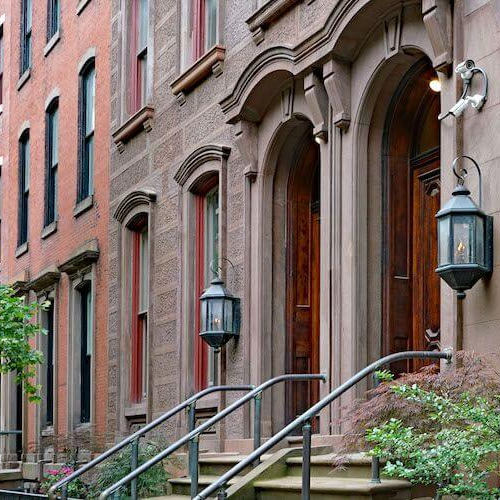Investing 101: How to buy multifamily property
Contributed by Sarah Henseler
Dec 14, 2025
•6-minute read

Multifamily investing can be an excellent way to earn passive income and build your real estate portfolio. You can invest in multifamily homes such as duplexes, fourplexes, and larger apartment buildings to help bring in rental income each month.
There’s a lot to consider when investing in a multifamily home, from the potential income to the amount of work that’s required. We’ll help you explore these pros and cons, as well as the process and requirements to buy a multifamily home, to help you decide if it’s right for you.
And if you’re ready to take the leap, Rocket Mortgage® offers financing for multifamily properties with up to four units.
What is a multifamily property?
A multifamily property is any residential building with two or more separate housing units, regardless of how many people live there. Examples of multifamily properties include duplexes, fourplexes, condos, townhouses, and apartment complexes.
Multifamily housing has become increasingly popular. In 2019, the last year for which data is available, multifamily housing made up roughly 31.4% of all housing in the United States, and roughly 33.7% of investment properties. Millions of people around the country live in multifamily housing of all kinds.
Multifamily investing is the process of buying a multifamily home with the goal of making money from it. You can earn passive income by renting out one or more of the units. Many people use a strategy called house hacking. You buy a multifamily property, live in one of the units, and rent out the other (or others) to help cover your mortgage payment.
Another way to make money from multifamily properties is by flipping them. You could buy a fixer-upper, renovate it, and then sell it for a profit.
You can use a residential loan to purchase any property with up to four units, but you’ll need a commercial loan for properties with five or more units.
Advantages of investing in multifamily homes
There are plenty of advantages to investing in multifamily homes, but only you can decide if it’s the right fit for you. Here are some benefits to consider:
- Generate passive income: Owning a multifamily rental property can generate income each month. And if you live in one of the units, you could pay most or all of your mortgage payment with the rental income you bring in.
- Expand your investment portfolio: Having a rental property expands your investment portfolio, allowing you to add exposure to real estate. Diversifying your portfolio can help reduce your investment risk.
- More scalable: Buying a multifamily home versus a single-family home allows you to immediately scale your real estate holdings. Rather than buying one unit at a time, you can buy several to generate increased income.
- Increased tax benefits: Real estate investors can write off many of their operating expenses, as well as mortgage interest, property taxes, and depreciation.
- Risk distribution: Owning a property with multiple units helps spread out your risk. If one tenant leaves, you’ll still have rental income coming in from your other units.
Disadvantages of investing in multifamily homes
Multifamily investing has some perks, but it’s also important to consider the downsides. While they won’t necessarily be deal-breakers for everyone, it’s important to go in with eyes wide open. Here are some downsides to consider:
- High up-front cost: You can expect to pay more for a multifamily home than you would for a single-family home in the same area. While the rental income can help offset the monthly costs, you’ll still have a higher upfront cost.
- Significant time cost: Managing a rental property is a lot of work. You’ll be responsible for getting the units ready, finding tenants, managing the property, and dealing with maintenance requests. You can hire a property manager, but that will reduce your net operating income.
- Vulnerable to market sensitivity: As the local real estate and rental market changes, so might your rental income, especially if you’re not located in a desirable area. Current supply and demand, interest rates, local job growth, and inflation can all affect your rental income.
- High taxes and insurance: Your property taxes and homeowners insurance costs will likely be higher on a multifamily home than they would on a single-family home in the same area. You’ll have to factor these costs in when you set your rent prices.
- Potential for turnover: When you own a rental property, you should plan for tenant turnover. You could go months or longer at a time in between tenants, and you’ll need the savings or income to cover the mortgage.
Financing a multifamily investment property
When you buy a multifamily home, you can finance some or all of the purchase price. A property with five or more units requires a commercial loan, and not all lenders offer this type of financing.
However, you can buy a property with four or fewer units with a traditional mortgage. Let’s talk about some of the financing options available.
Conventional loans
A conventional loan, which is the most popular type of mortgage, is any home loan that’s not a part of a government program. Conventional conforming loans must meet the requirements set by Fannie Mae and Freddie Mac.
For a multifamily home that’s your primary residence, you can have a down payment as low as 5%. For investment properties, meaning those you won’t live in, you’ll need to put at least 25% down. Any down payment less than 20% will result in the additional cost of private mortgage insurance (PMI).
Conventional loans generally require a credit score of at least 620. However, some lenders may prefer to see a higher score, especially if it’s an investment property or you have a lower down payment.
The table below shows how much you can borrow for a multifamily conventional loan based on the number of units and whether you live in a low-cost or high-cost area, according to Fannie Mae and Freddie Mac:
| Number of units | Low-cost area | High cost area |
|---|---|---|
| One unit | $806,500 | $1,209,750 |
| Two units | $1,032,650 | $1,548,975 |
| Three units | $1,248,150 | $1,872,225 |
| Four units | $1,551,250 | $2,326,875 |
FHA loans
An FHA loan is a mortgage that’s backed by the Federal Housing Administration. These loans are specifically designed for borrowers with low credit scores. For example, unlike the conventional loan credit score of 620, you can get an FHA loan with a credit score as low as 580 with a 3.5% down payment or 500 with a 10% down payment.
It’s important to note that Rocket Mortgage offers FHA loans with credit scores as low as 580 and down payments as low as 3.5%.
You can only use an FHA loan to purchase a property with up to four units as long as you plan to use one of the units as your primary residence.
The table below shows how much you can borrow for a multifamily FHA loan based on the number of units and whether you live in a low-cost or high-cost area:
| Number of units | Low-cost area | High cost area |
|---|---|---|
| One unit | $524,225 | $1,209,750 |
| Two units | $671,200 | $1,548,975 |
| Three units | $811,275 |
$1,872,225 |
| Four units | $1,008,300 | $2,326,875 |
VA loans
A VA loan is a type of mortgage that’s backed by the U.S. Department of Veterans Affairs. They’re available to military veterans, servicemembers, and reservists who meet certain service requirements, as well as eligible surviving military spouses.
A key feature of VA loans is that they don’t require a down payment. Instead, the VA guarantees the loan, and you’ll only have to pay a small funding fee. There’s no minimum credit score, but many lenders require scores of 620 or higher. You can qualify for a VA loan from Rocket Mortgage with a credit score as low as 580.
You can use a VA loan to buy a multifamily home of up to four units. Like with an FHA loan, you can only use a VA loan for your multifamily property if you plan to live in the home. You have to move into the home within a reasonable time, which the VA defines as 60 days.
Unlike other loan types, VA loans don’t have maximum loan limits. You can borrow as much as you want as long as your lender allows it, your finances qualify for it, and you have remaining loan entitlement.
How to find a multifamily real estate investment
If you’re ready to start shopping for a multifamily real estate investment, here are some places you may be able to find properties:
- Online auctions
- Multiple listing service (MLS)
- Real estate agents
- FSBO (for sale by owner) properties listings
Make sure you understand your local real estate market, research local neighborhoods, and get an idea of what local renters want. Finally, consider working with a local real estate agent who understands the local housing and rental market and can help you find a property that fits your needs.
The bottom line: There are multiple ways to fund multifamily property investments
Investing in a multifamily property can help you jumpstart your real estate portfolio and start earning passive rental income. There are plenty of ways to go about it – from house hacking a duplex, living in one side and renting out the other, to buying an apartment building to fill with tenants, any real estate investor can find the right fit.
If you’re planning to purchase a multifamily property, make sure to get preapproved before you’re ready to make an offer. Apply for a home loan today with Rocket Mortgage to see what you qualify for.
Rocket Mortgage is a VA-approved lender, not endorsed or sponsored by the Dept. of Veterans Affairs or any government agency.
To qualify for this offer, you must meet all standard FHA eligibility requirements. In addition, your total mortgage payment, including taxes and insurance, cannot exceed 38% of your income, your debt-to-income (DTI) ratio cannot exceed 45%, and you must have 12 months of verifiable housing history immediately prior to your application, no late payments 30 days or greater in the last 12-months, and no derogatory marks on your credit report. Not available on jumbo loans. Asset statements may be needed, no more than 1 day of non-sufficient fund fees are allowed in the most recent 2 months prior to application. Additional restrictions/conditions may apply.

Erin Gobler
Erin Gobler is a freelance personal finance expert and writer who has been publishing content online for nearly a decade. She specializes in financial topics like mortgages, investing, and credit cards. Erin's work has appeared in publications like Fox Business, NextAdvisor, Credit Karma, and more.
Related resources
7-minute read
Understanding the BRRRR method of real estate investment
The BRRRR Method is a real estate investment strategy that involves flipping distressed property. Learn about the steps involved in the BRRRR strategy.
Read more
6-minute read
What is rental property depreciation and how does it work?
Rental property depreciation is a big tax advantage that can make real estate investment profitable beyond the income it generates. Learn how it works.
Read more
6-minute read
How to refinance an investment property
Thinking about refinancing your investment property? Learn about refinancing, why you might benefit, and the steps you must take to get through the process.<...
Read more